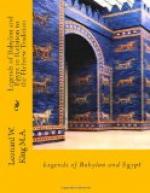If this had been the only version of the story that had come down to us, we should hardly have regarded it as a record of world-wide catastrophe. It is true the gods’ intention is to destroy mankind, but the scene throughout is laid in Southern Babylonia. After seven days’ storm, the Sun comes out, and the vessel with the pious priest-king and his domestic animals on board grounds, apparently still in Babylonia, and not on any distant mountain, such as Mt. Nisir or the great mass of Ararat in Armenia. These are obviously details which tellers of the story have added as it passed down to later generations. When it was carried still farther afield, into the area of the Eastern Mediterranean, it was again adapted to local conditions. Thus Apollodorus makes Deucalion land upon Parnassus,(1) and the pseudo-Lucian relates how he founded the temple of Derketo at Hierapolis in Syria beside the hole in the earth which swallowed up the Flood.(2) To the Sumerians who first told the story, the great Flood appeared to have destroyed mankind, for Southern Babylonia was for them the world. Later peoples who heard it have fitted the story to their own geographical horizon, and in all good faith and by a purely logical process the mountain-tops are represented as submerged, and the ship, or ark, or chest, is made to come to ground on the highest peak known to the story-teller and his hearers. But in its early Sumerian form it is just a simple tradition of some great inundation, which overwhelmed the plain of Southern Babylonia and was peculiarly disastrous in its effects. And so its memory survived in the picture of Ziusudu’s solitary coracle upon the face of the waters, which, seen through the mists of the Deluge tradition, has given us the Noah’s ark of our nursery days.
(1) Hesiod is our earliest
authority for the Deucalion Flood
story. For its
probable Babylonian origin, cf. Farnell,
Greece and Babylon
(1911), p. 184.
(2) De Syria dea, 12 f.
Thus the Babylonian, Hebrew, and Greek Deluge stories resolve themselves, not into a nature myth, but into an early legend, which has the basis of historical fact in the Euphrates Valley. And it is probable that we may explain after a similar fashion the occurrence of tales of a like character at least in some other parts of the world. Among races dwelling in low-lying or well-watered districts it would be surprising if we did not find independent stories of past floods from which few inhabitants of the land escaped. It is only in hilly countries such as Palestine, where for the great part of the year water is scarce and precious, that we are forced to deduce borrowing; and there is no doubt that both the Babylonian and the biblical stories have been responsible for some at any rate of the scattered tales. But there is no need to adopt the theory of a single source for all of them, whether in Babylonia or, still less, in Egypt.(1)




